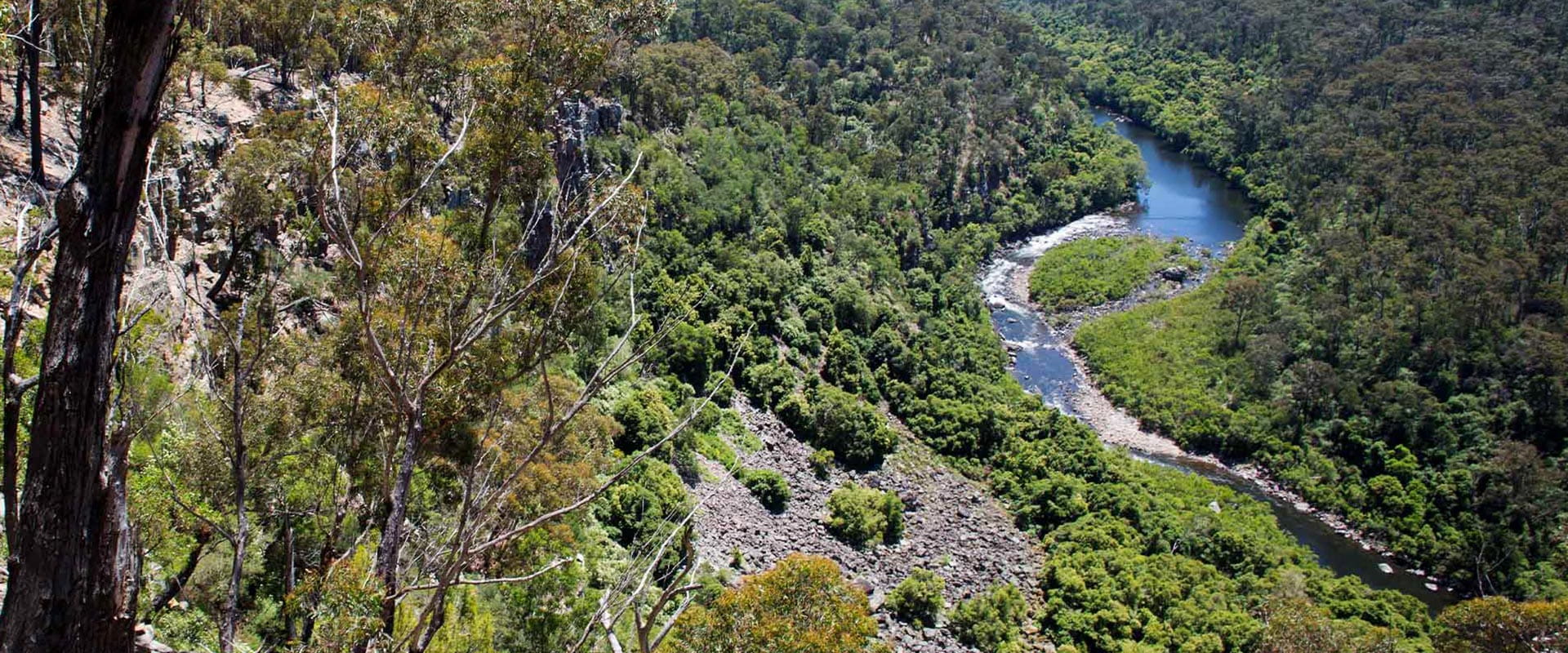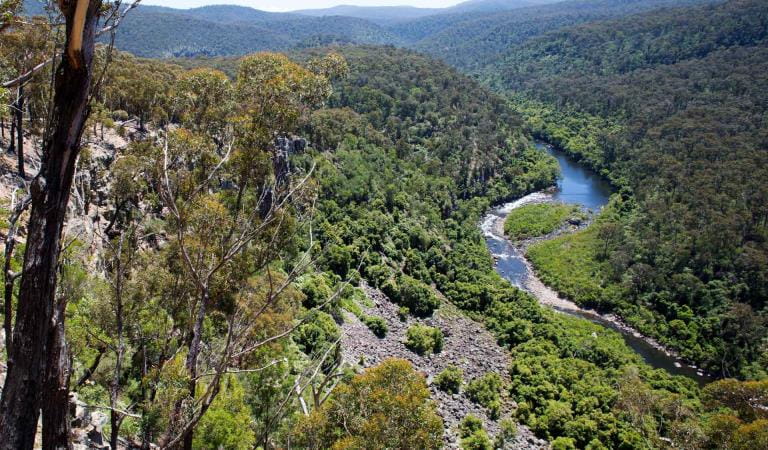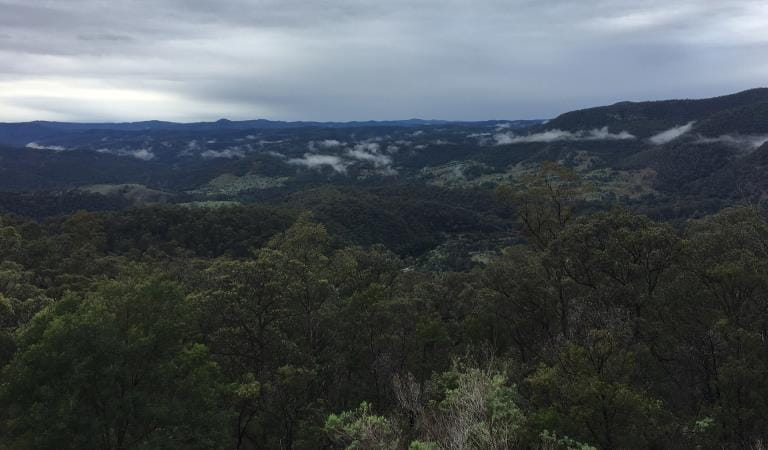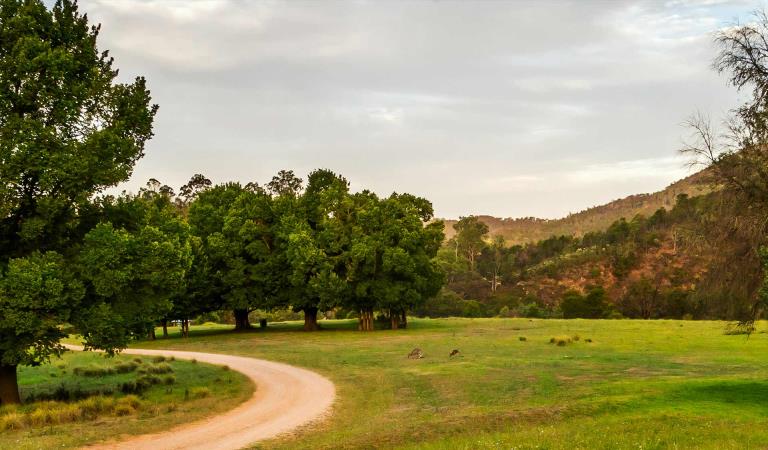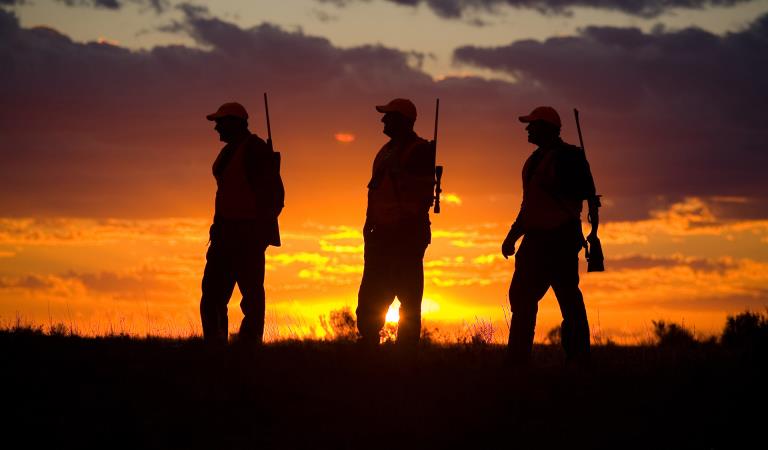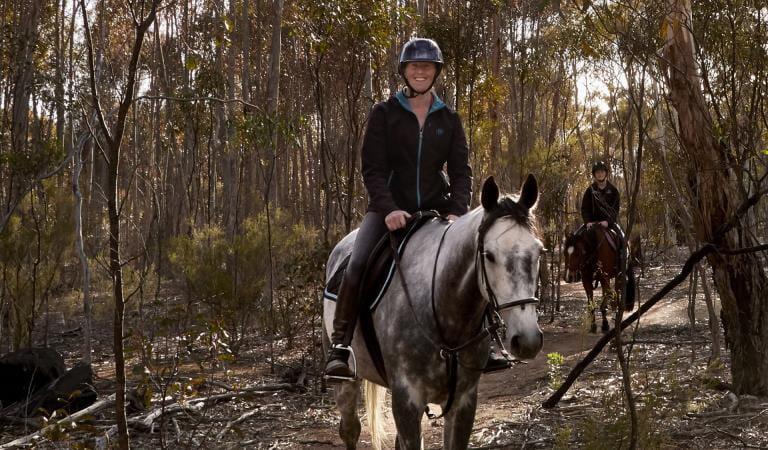Explore
Mitchell River National Park

Mitchell River National Park is one of the jointly managed parks within Gippsland. The Joint Management agreement recognises the fact that the Gunaikurnai people hold Aboriginal Title and maintain a strong connection to Country. As custodians of the land, they are the rightful people who speak for their Country. These parks and reserves are cultural landscapes that continue to be part of Gunaikurnai living culture. For more information on Joint Management, please visit the Gunaikurnai Traditional Owner Land Management Board and the Gunaikurnai Land and Waters Aboriginal Corporation.
Mitchell River National Park, on Brabralung Country, is highly significant to Gunaikurnai Traditional Owners due to its remarkable Aboriginal cultural heritage.
Walk through the rainforest gully to the Den of Nargun and absorb the eerie atmosphere from a safe distance. Tradition has it the Nargun, a fierce being, half human and half stone, lives there. The Gunaikurnai people and Parks Victoria ask you to respect this special place by not entering the cave.
Enjoy the loop walk at the Den of Nargun, where you can access the Mitchell River for a swim during the warmer months. Walk into Deadcock Den and see Eastern Water Dragons relaxing in the sun, and check out the panoramic view of the Den loop track and the wider park landscape from the lookout. From here you can return to the Den of Nargun picnic area for a spot of lunch or afternoon tea. Toilets, a picnic shelter and tables, gas barbecue and fire places are provided.
Billy Goat Bend is also a popular spot for a picnic, with basic facilities and panoramic views of the Mitchell River Gorge and rapids from the Lookout point. The Billy Goat Bend Camp area also has toilets, picnic tables and fire places for campers and day visitors, and provides a perfect resting point for those hiking along the Mitchell River Walking Track between Angusvale and the Den of Nargun.
Brabralung Country
Mitchell River National Park has a rich cultural history that tells of tribal conflict, ceremonies, food gathering, community life and local spirits. It is rocky country that has rugged gorges... good lookout points for our ancestors, used for safety and defence... There are important places throughout this park — Angusvale was a good source of food, medicine and materials, and Billy Goat Bend had reliable water. Deadcock Den is important to the Gunaikurnai people. The Den of Nargun, a cave behind a waterfall, is a place of great cultural significance to the Gunaikurnai people, especially women… and may have been used for women’s initiation and learning ceremonies.
Gunaikurnai Whole-of-Country Plan (GLaWAC 2015)
The park and gorge was a stopping‐off point for Gunaikurnai travelling to the high country. Today, it provides an easily accessible entry into the fringes of the Victorian Alps and a sense of remoteness from the plains due to the enclosed gorge and valleys.
Preserving the past is important to better manage our cultural landscapes. Patrick Mullett is a proud Gunaikurnai man working on Country to manage Aboriginal cultural heritage. He assesses sites and provides advice under the Aboriginal Heritage Act 2006 on how to best protect cultural heritage.
Things To Do
Cultural Heritage
Walking in Mitchell River National Park
Camping at Mitchell River
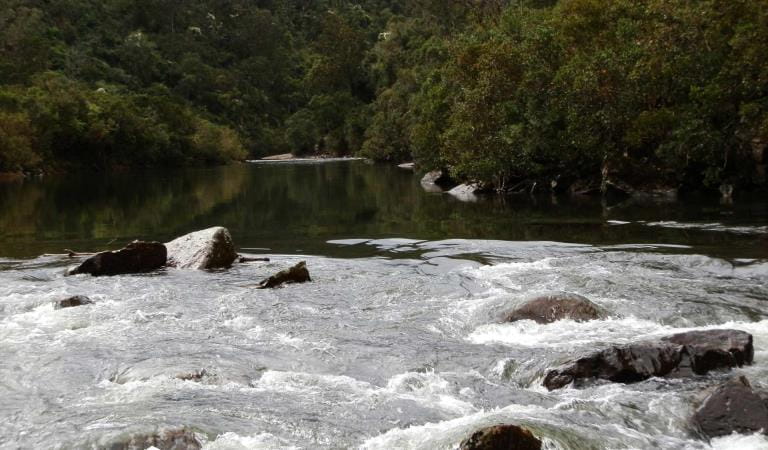
Canoeing and rafting at Mitchell River
Hunting in Mitchell River National Park
Horse riding in Mitchell River National Park
Mitchell River National Park
This area is well known for its wildlife. Keep an eye out for:
Tours and adventure experiences in parks
One of the best ways you can get into nature is with a Licensed Tour Operator.
There are more than 400 Licensed Tour Operators across Victoria who are ready and waiting to help you experience and connect with Victoria’s spectacular parks and waterways.
Discover more than 60 different types of nature-based experiences including hiking, mountain biking, boating, four-wheel driving, indigenous culture tours, birdwatching, surfing, diving and so much more.
Licensed Tour Operators know all the best places to go and will plan and prepare your visit to ensure you are safe and can enjoy your nature-based adventure to the fullest.
How to get there
Mitchell River National Park
Heading west out of Bairnsdale on Main Street/Princes Highway/A1, turn right onto Bairnsdale-Dargo Road/C601 and follow for about 42 kilometres. You can turn right at Wallers Road and follow that to the end to reach the Den of Nargun picnic area. Forr access to Billy Goat Bend camping area, either turn left off Wallers Road and head north along Park Road, or turn right off the Bairnsdale-Dargo Road/C601 onto Billy Goat Bend Road, and follow the signs to the camping area.
Angusvale campground is located at the end of Mitchell River Road, further north along the Bairnsdale-Dargo Road/C601. Turn right off the C601 and follow the track for 16 kilometres.
To access the eastern side of the park, turn right off the C601 onto Lindenow-Glenaladale Road. Cross the bridge over the Mitchell River and turn left to stay on Lindenow-Glenaladale Road. Turn right at Weir Road and stay on it until you are continuing along Wattle Creek Road and see entry signs to the park.
To visit the Old Weir day visitor site, turn left off Weir Road onto Milton Park Road. Please be aware that the end of this road down into the day visitor site is rated as a Double-Black Diamond 4WD track, and is suitable for experienced four-wheel-drivers only. Visitors can access the site on foot - park your vehicle at the top of the hill and walk approximately one kilometre to the site. Please take plenty of water.
When you're there
Need to know
Mitchell River National Park
Accessibility
Visiting a park can be more of a challenge for people with disabilities, however in Victoria there are a wide range of facilities to help people of all abilities enjoy our wonderful parks around the state.
Driving in the park
All roads and tracks within the park are gravel, with the Mitchell River Road and Wallers Road being readily accessible for most vehicles. All other tracks would require a 4WD to navigate, with varying levels of experience required. Find more safety tips on our Safety in nature page.
Assistance Dogs
Assistance dogs are welcome in Parks Victoria parks and reserves. Entry requirements apply for parks and reserves that are usually dog prohibited, such as national parks.
Change of Conditions
Nature being nature, sometimes conditions can change at short notice. It’s a good idea to check this page ahead of your visit for any updates.
-
Rock Creek (Mitchell River National Park, Mitchell and Wonnangatta Rivers Heritage River)
Change of conditions for Horton's Crossing expires
Angusvale Track/Horton’s Crossing ClosureDue to storm events, the Angusvale Track past the Rock Creek Camp area has been subject to landslip.This Landslip now prevents vehicles from accessing the ford crossing through the Mitchell River between Angusvale Track and Hortons Track. Please do not attempt to cross the river from Hortons Track as there is no access to the West side of the park from this point.The Rock Creek Camp area is still currently accessible via Angusvale Track/Mitchell Views Track of the Mitchell River Road. -
Angusvale camping area (Mitchell and Wonnangatta Rivers Heritage River, Mitchell River National Park)
No access to canoe launch
Canoe launch area is closed for public safety. Please use the launching area in the day visitor site for river access.
How we keep it special
Mitchell River National Park is on the Country of the Brabralung clan. The park has a rich cultural history that tells of tribal conflict, ceremonies, food gathering, community life and local spirits. The Gunaikurnai and Victorian Government Joint Management Plan provides a description of joint management strategies and actions that are specific to Mitchell River National Park.
The East Gippsland Conservation Action Plan provides directions for environmental conservation management across the diverse landscape, including Mitchell River National Park. This covers the varied ecosystems across the area which range from heathlands to forests, woodlands, wetlands and other marine environments.


